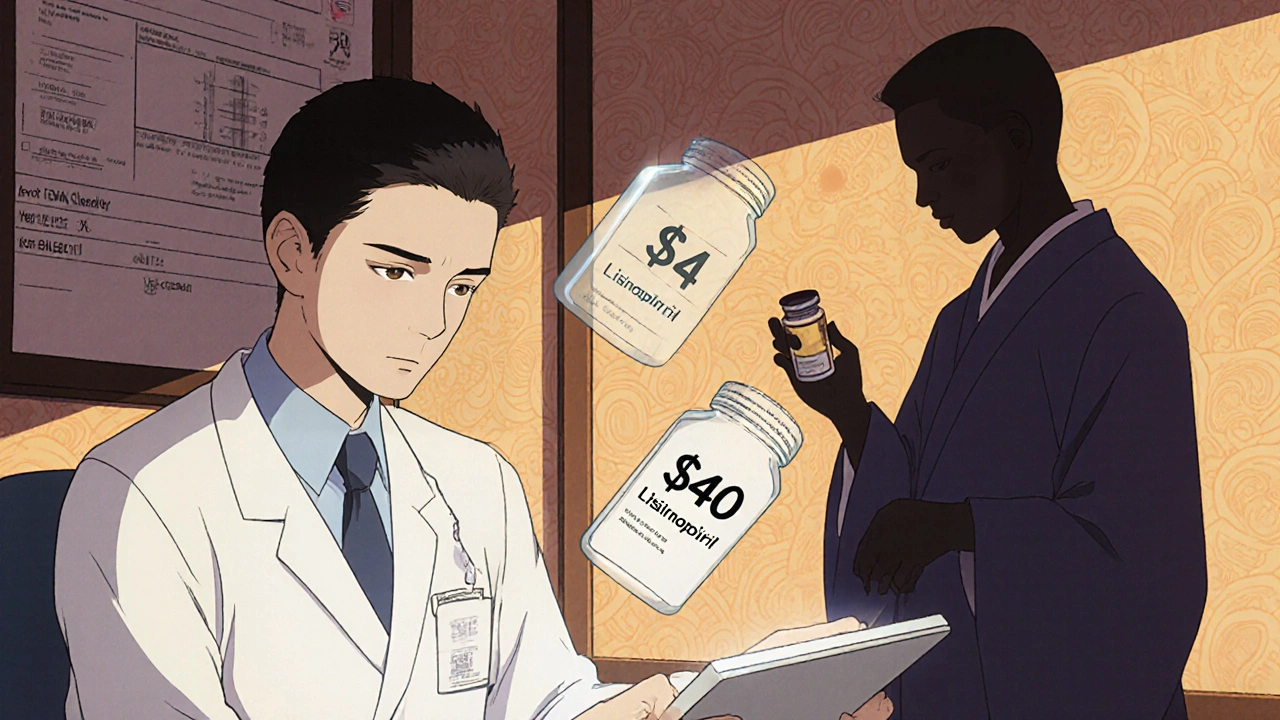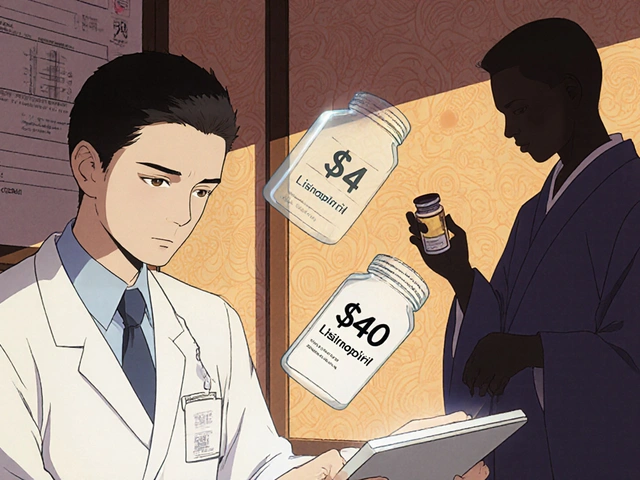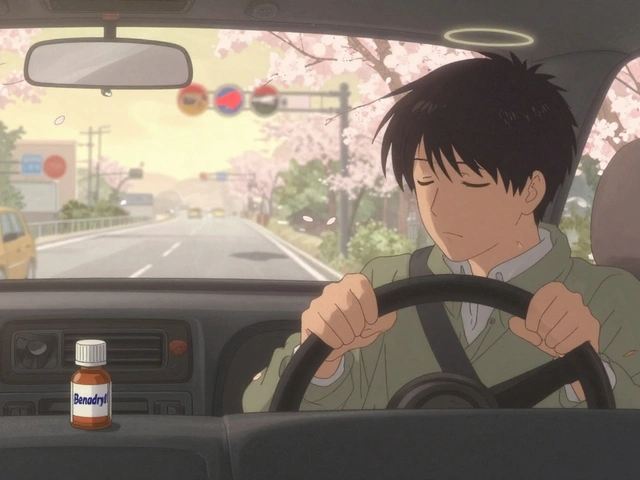Imagine you’re a doctor. Your patient walks in with high blood pressure. You reach for your tablet, type in a name - lisinopril - and hit send. But you have no idea if that pill costs $4 or $40. You don’t know if the patient can afford it. You don’t even know if there’s a cheaper alternative sitting right next to it on the shelf. This isn’t rare. It’s normal.
Doctors are guessing drug prices - and getting it wrong
Studies show most clinicians don’t know how much medications cost. Not even close. A 2007 review of 29 studies found doctors overestimated the price of cheap drugs by 31% and underestimated expensive ones by 74%. That’s not a small mistake. That’s a system-wide blind spot.
Take generic drugs. They’re supposed to be affordable. But in one study, 77.5% of doctors overestimated their cost. Meanwhile, brand-name drugs like Humira or Eliquis? Doctors thought they cost less than they actually do. This isn’t about ignorance - it’s about lack of access. No one teaches you drug pricing in medical school. No one gives you a price list at the point of care. You’re left to guess.
Only 5.4% of doctors and students could estimate the cost of a generic drug within 25% of its actual price. For brand-name drugs? Just 13.7%. That means 9 out of 10 times, the doctor prescribing the medication has no idea what the patient will pay out of pocket.
Why does this matter? Because patients skip doses - or skip pills entirely
When doctors don’t know the cost, patients pay the price. Nearly 3 in 10 adults in the U.S. say they’ve skipped a dose, cut a pill in half, or not filled a prescription because of cost. That’s not just inconvenient - it’s dangerous. Uncontrolled diabetes. Unmanaged hypertension. Worsening asthma. All of it tied to something as simple as a price tag.
And here’s the kicker: 82% of Americans say drug prices are unreasonable. Yet doctors rarely talk about cost during appointments. Why? Because they don’t have the data. They don’t know what’s affordable. They don’t know what their patient’s insurance covers. They’re flying blind.
The EHR fix: Real-time cost alerts are working
But there’s hope. The biggest breakthrough in clinician cost awareness isn’t a new law or a protest - it’s technology. Electronic Health Records (EHRs) that show real-time drug prices at the point of care are changing the game.
A 2021 JAMA Network Open study found that when doctors saw out-of-pocket costs pop up on their screen while writing a prescription, they changed their choice 1 in 8 times. When the potential savings were over $20, that number jumped to 1 in 6. That’s not a small impact. That’s hundreds of thousands of prescriptions saved per year.
At UCHealth, after implementing cost alerts in their Epic system, 12.5% of prescriptions were switched to lower-cost alternatives. One doctor told researchers he’d saved a patient $1,200 a year just by switching from a brand-name statin to a generic. That’s not a theoretical win. That’s real money in someone’s pocket.

But the alerts aren’t perfect - and that’s the problem
Here’s the catch: Most EHR cost tools show list prices or insurer-negotiated rates. They don’t show what the patient actually pays. One resident on Reddit wrote: “The system says the drug costs $15. But my patient’s copay is $90 because their deductible hasn’t been met.” That’s not helpful. That’s misleading.
Another issue? Fragmentation. The same drug can cost $15 at Walmart and $320 at a pharmacy down the street. EHRs rarely account for this. Patients have to go to multiple pharmacies to find the best price - but doctors aren’t trained to guide them there.
Even when systems work, adoption is low. Only 37% of U.S. hospitals have real-time benefit tools (RTBTs) in place as of late 2024. Why? Because it’s expensive. UCHealth spent $2.3 million and 18 months building their system. Most clinics don’t have that kind of budget.
Who’s learning? Who’s not?
It’s not just about tools - it’s about training. Medical students who’ve gone through formal pharmacotherapy education score higher on drug pricing knowledge. But here’s the shocker: 56% of U.S. medical schools still don’t teach drug pricing at all.
Doctors under 40 are far more likely to use cost tools than those over 55. Why? They grew up with digital interfaces. They’re more comfortable with tech-driven decisions. Older doctors? They rely on memory, habit, or what’s in the formulary book - which is often outdated.
And here’s something even more troubling: Only 44% of medical students understand that drug prices have almost nothing to do with research and development costs. Most think expensive drugs are expensive because they’re “new” or “innovative.” In reality, price hikes often happen years after patent expiration - with no new science behind them.

The policy shift: Medicare can now negotiate prices
The 2022 Inflation Reduction Act changed the game. For the first time, Medicare can negotiate prices for 10 high-cost drugs - and that number will grow to 20 by 2026. It’s a historic move, backed by 80% of Americans across party lines.
But this isn’t just about government action. It’s about shifting the culture. The American Medical Association and the American College of Physicians have both made cost-conscious prescribing a core part of their guidelines since 2012. That means it’s no longer optional. It’s professional responsibility.
Doctors are starting to see it: Choosing a cheaper drug isn’t giving less care - it’s giving smarter care. A 2023 JAMA Internal Medicine study found patients whose doctors used cost alerts saved $187 per year on average. That’s not just a number. That’s groceries. That’s gas. That’s insulin they can afford to refill.
What’s next? Value over price
The future isn’t just about knowing the cost. It’s about understanding value. A $500 drug might be worth it if it prevents hospitalization. A $5 drug might be useless if it doesn’t work. The best systems now combine cost data with clinical outcomes - showing not just price, but expected benefit.
By 2027, 75% of U.S. health systems are expected to use advanced tools that do this. But we’re not there yet. Right now, most tools still show price alone. That’s like giving a chef a price list for ingredients but no recipe.
And while regulators crack down on unjustified price hikes - like Humira’s 4.7% increase with no new indication - the system still rewards companies that raise prices, not those that deliver value.
The bottom line: Knowledge is power - for patients and providers
Doctors want to know drug prices. A 2007 survey found 92% of physicians said they wanted cost information at the point of care. But they didn’t have it. Today, some do. And when they do, they change prescriptions. Patients take their meds. Health improves.
This isn’t about cutting corners. It’s about cutting waste. It’s about aligning care with what people can actually afford. It’s about making sure the person writing the prescription isn’t just thinking about the disease - but the person sitting across from them.
Cost awareness isn’t a bonus skill. It’s part of being a good doctor. And the data proves it: When doctors know the price, patients get better.
Do most doctors know how much medications cost?
No. Studies show the majority of clinicians misestimate drug prices - often by huge margins. They overestimate cheap generics by 31% and underestimate expensive brand-name drugs by 74%. Only about 5% of doctors can estimate generic drug costs within 25% of the actual price.
Why don’t doctors know drug prices?
Medical schools rarely teach drug pricing. There’s no standard price list at the point of care. Insurance plans vary wildly, and pharmacy prices change daily. Without real-time tools built into electronic health records, doctors are left guessing - or relying on outdated memory.
Can real-time cost alerts in EHRs help?
Yes. When doctors see out-of-pocket costs while prescribing, they change prescriptions 1 in 8 times - and up to 1 in 6 when savings exceed $20. Tools like those used at UCHealth have cut patient costs by an average of $187 per year. But only 37% of U.S. hospitals have these tools.
Why are cost alerts sometimes inaccurate?
Many EHR systems show insurer-negotiated prices or list prices - not what the patient actually pays. A patient’s copay depends on their deductible, plan type, and pharmacy. If the system doesn’t integrate with the patient’s specific insurance, the alert can be misleading - sometimes worse than no info at all.
Are cheaper drugs always better?
Not always. The goal isn’t just the lowest price - it’s the best value. A slightly more expensive drug might work better, reduce side effects, or prevent hospital visits. The smartest systems now combine cost data with clinical outcomes to help doctors choose based on both price and effectiveness.
Is drug pricing taught in medical school?
No - not in most places. 56% of U.S. medical schools don’t include drug pricing in their curriculum. Students often graduate without understanding how prices are set, why generics cost less, or how insurance affects out-of-pocket costs.
What’s being done to fix this?
The 2022 Inflation Reduction Act lets Medicare negotiate drug prices. Professional groups like the AMA and ACP now require cost-conscious prescribing. Hospitals are investing in real-time cost tools. And more schools are starting to teach pricing - slowly. But progress is uneven and still too slow.






Let me tell you something-this isn’t just a gap, it’s a fucking chasm. 🤯 Doctors are trained to diagnose, treat, cure-but not to navigate the labyrinthine, predatory pricing of Big Pharma. We’re talking about life-or-death decisions made in the dark. And the EHR cost alerts? Half-assed. They show list prices, not copays. A patient’s $90 copay isn’t $15 because their deductible’s still $5,000 deep. That’s not transparency-it’s torture. We need real-time, patient-specific, pharmacy-level pricing integrated directly into the workflow. Not optional. Mandatory. Like vital signs.
I’ve seen this firsthand. My dad’s on lisinopril, and his pharmacy bill jumped $120 last month because the system didn’t tell the doctor his deductible reset. He skipped doses for two weeks. He didn’t want to worry us. I wish the EHR had just popped up: 'This drug costs $3 at Walmart. Try there.' Simple. Human. It shouldn’t take a family crisis to fix this.
Why are we surprised? Medical schools don’t teach this because the system doesn’t want doctors to know. If they knew how much drugs really cost, they’d start asking questions. And if they started asking questions, the whole pricing model would collapse. It’s not ignorance-it’s design.
why do doctors even care about price they just write scripts and get paid anyway lol
USA is a joke. Other countries don’t have this mess. In India, a month of lisinopril costs $0.50. Here? $40. And doctors are shocked? LOL. You built a system where profit > people. Now you want a tech fix? Fix the system. Not the EHR. Fix the greed.
Let me be perfectly clear: This is not a technological failure-it is a moral collapse. The fact that we are even debating whether doctors should know how much their prescriptions cost reveals a grotesque inversion of values. We have turned healthcare into a commodity, and patients into balance sheets. The real tragedy? We’ve normalized it. We’ve made it routine. We’ve made it... acceptable. And now we’re putting band-aids on arterial bleeds with EHR pop-ups. Please. We need systemic overhaul. Not a UI update.
Y’all are missing the point. This isn’t about tech or training-it’s about culture. Doctors are scared to talk about money. They think it’s rude. They think it’s not their job. But here’s the truth: It’s their job to keep people alive. And if a patient can’t afford the script? That’s not a pharmacy problem. That’s a clinical failure. We need to train residents to say: 'I know this costs $5. Let’s get it today.' Not 'I’ll prescribe this and hope.' That’s the new standard of care. And it’s not optional.
Real talk: The 12.5% switch rate at UCHealth? That’s a drop in the bucket. We’re talking about hundreds of thousands of patients every day being prescribed drugs they can’t afford. And the tools? Most are broken. They show list prices. They don’t account for pharmacy networks. They don’t know if the patient’s on Medicare Advantage or Medicaid. And the worst part? The vendors who build these tools don’t even talk to frontline clinicians. They build for billing departments. Not for people. We need a grassroots movement. Doctors demanding real data. Not corporate dashboards. Real, live, patient-specific cost info. Or we’re just playing pretend.
Let’s be honest-the 1 in 8 prescription change rate is statistically insignificant. The sample sizes in these studies are tiny. And how many of those switches were clinically appropriate? We don’t know. This whole narrative feels like PR. Big Pharma isn’t threatened by a $5 generic switch. They’re laughing. The real cost drivers? Biologics. Specialty drugs. And those aren’t being touched. This is a distraction. A feel-good metric for administrators. Not a solution.
Wow. So doctors are just dumb? They don’t know prices? Newsflash-they’re not accountants. Their job is to treat disease. Not to be pharmacy price comparators. If patients can’t afford meds, that’s a social problem. Fix insurance. Fix poverty. Don’t dump the burden on doctors who are already burned out. This is virtue signaling dressed up as innovation. Stop making them feel guilty for a system they didn’t create.
Oh please. The Inflation Reduction Act? A political stunt. Medicare negotiating prices? What’s next? Government setting the price of iPhones? This is socialism with a stethoscope. If you want cheap drugs, stop paying for R&D. Let the market decide. But don’t make doctors the scapegoats for your ideological crusade. They’re trying to save lives-not play accountant for the welfare state.